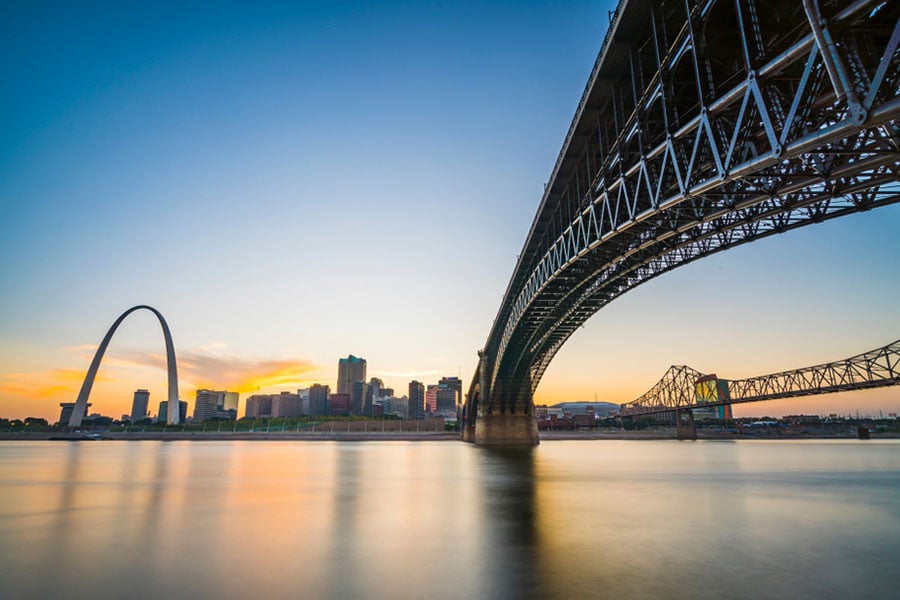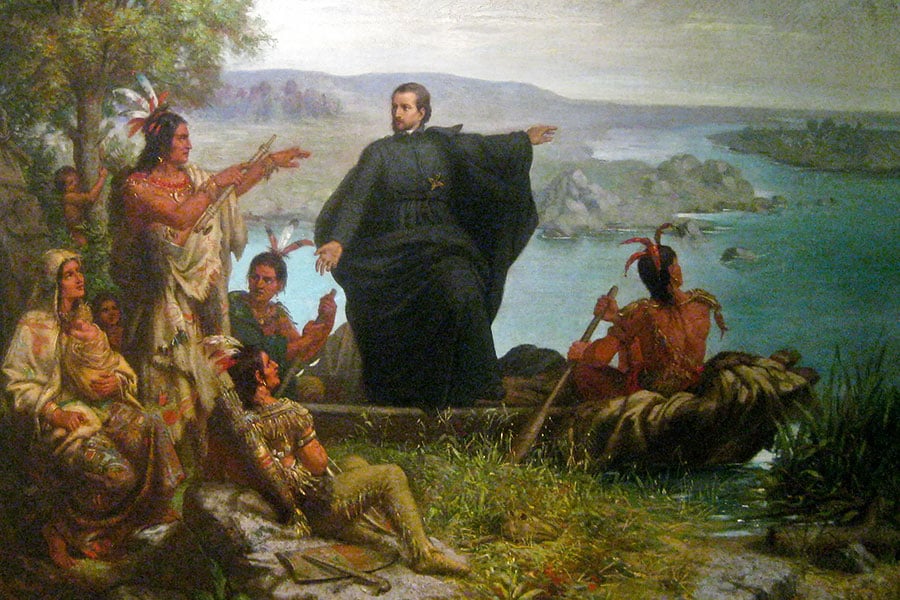The mighty Mississippi was once named ‘River of the Immaculate Conception.’ Here’s why

Mississippi River in front of the St. Louis skyline.
“Immaculate” is not a word most people would use to describe the Mississippi River’s famously muddy waters. But Father Jacques Marquette was not most people.
The Jesuit explorer, who came from France as a missionary to Canada in 1666, was one of the first Europeans to name the Mississippi, which he explored and mapped with his companion Louis Joliet beginning in 1673. And the name he gave to this vital artery of North America was “The River of the Immaculate Conception.”
The entrustment of this mighty waterway — one of the largest and most important rivers in the world — to the Virgin Mary was part of the French Jesuits’ mission to evangelize the Native Americans of the area, which by all accounts they did, not with violence but with fellowship and respect.
French missionary activity in North America was driven by great devotees to Mary, like Father Marquette, who had a vision of the meeting of two civilizations — European and Native American — under the Catholic faith, rather than a conquest of the land, said James Wilson, professor of humanities at St. Thomas University in Houston.
“They set out on their canoes entrusting themselves entirely to God’s grace, entrusting themselves entirely to Mary as the Immaculate Conception, and they didn’t seek to build lasting monuments to their conquests or to plant flags,” Wilson, author of a seven-part poem called “River of the Immaculate Conception,” noted.
“They sought primarily to enter as agents of grace among the Indians and to live with them, preach to them, and enter into communion with them.”
Of course, the Mississippi today bears its original, Native-given name, which roughly translates to “great waters.” But Wilson said far from being a footnote in history, Marquette’s consecration of the Mississippi endures as a testament to how God’s grace was already working in North America. Nearly two centuries later, in 1846, the bishops of the now United States declared Mary, under the title of the Immaculate Conception, as the patroness of the country.
The church on Immaculate Conception River
Though forgotten by most, the “River of the Immaculate Conception” endures in the memories of one community in particular: the congregation at the Immaculate Conception Chapel in Kaskaskia, Illinois.

Kaskaskia was, at one time and in some ways, the center of the Mississippian universe. The now-tiny hamlet, located on the river, predates the historic riverside metropolises of New Orleans to the south and St. Louis to the north. Known at one time as the “Grand Village,” Kaskaskia was a prosperous nexus of trade for Natives and French trappers alike. The town of 1,900 people was the logical — and in some ways the definitive — place for Catholic missionaries to use as their evangelical hub.
Emily Lyons, the historian at the Immaculate Conception Chapel in Kaskaskia, told CNA that the church’s founder, Marquette, had an “absolute devotion to the Immaculate Conception.” He entrusted anything and everything he could to Mary’s care.
Marquette founded the mission at Kaskaskia on Easter Sunday in 1675 and died later that year.
Since that time, the church dedicated to Mary in Kaskaskia has endured as a remarkable testament to God’s grace. Lyons said since the earliest days, when the church was a simple structure of upright logs, the congregation has “worn out about five different buildings.”
The island on which Kaskaskia sits is extremely prone to flooding, and the church has had to be moved several times over the years. The current brick church dates to 1894 and endured significant damage in the major Mississippi floods of 1993. The next year, the Diocese of Belleville designated it a chapel. Today, the once thriving village of Kaskaskia only has about two dozen residents.
Though no longer a parish, Immaculate Conception Chapel still attracts many visitors and worshippers. Lyons said every year on or around the solemnity of the Immaculate Conception on Dec. 8, the community has a celebratory Mass whereby they sing Marian hymns translated into the Algonquin language. The liturgy has attracted many Native American Catholics over the years, she said.
The congregants also hold a procession and reenact a purported miracle that occurred at the church many years ago, whereby a young Native woman found lilies growing near the church — despite the prohibitive winter cold — and brought them inside as an offering for Mary.
God’s grace in America
Unlike the Spanish, whose conquest of North America was often marked by brutality, the French entered with “relative peacefulness” and largely respected the humanity of the Natives, Wilson said. Many of the Natives were subsequently converted and incorporated Christianity into their way of life.
To meditate on this, Wilson says, is to reconceive of the United States not as a wild frontier later tamed by man but as “a stage where God’s grace is the first actor.” The French Jesuits, through their devotion to prayer and to the devout life, were attuned to this reality, Wilson said.
“To consecrate the Mississippi River as the ‘River of the Immaculate Conception’ is not to plant a flag or to lay conquest. It’s rather to recognize that this vast, open continent must, objectively speaking, be defined primarily not by what any human being does but by the actions of God through his grace,” Wilson said.
“Even when Christians try to talk about history, they talk as though only humans have acted in history and don’t consider that God is always the primary author of every action, and God's grace is the most dynamic agent of everything in history.”
By Jonah McKeown, Catholic News Agency
